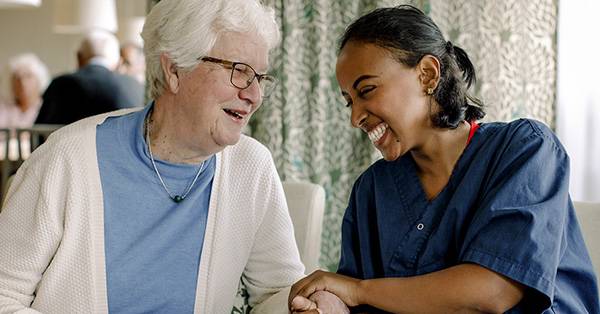- Solutions
- Solutions
- Home Health
- Hospice
- Life Plan Community
- Palliative Care
- Private Duty
- Senior Living
- Skilled Nursing
- Skilled Nursing
- Skilled Nursing Software
- Advanced Insights
- Customer relationship management
- Data and analytics
- Financial & operations management
- Marketing
- Nutrition management
- Referral management
- Regulatory compliance
- Retail management
- Resident engagement
- Revenue cycle management
- Skilled nursing interoperability
- Partners
- Blogs
- Resources
- About
- User Conference

Breaking down the CMS minimum staffing rule
The Centers for Medicare & Medicaid Services (CMS) recently issued its final rule setting new federal standards for how much time nurses must spend caring for long-term care residents. The Minimum Staffing Standards for Long-Term Care (LTC) Facilities and Medicaid Institutional Payment Transparency Reporting rule applies to Medicare- and Medicaid-certified long-term care facilities.
Fast facts about the new rule
- Nursing care: Residents must receive at least 3.48 hours of nursing care per day, which would include at least 0.55 hours of care (33 minutes) from an RN per resident, per day, and 2.45 hours (147 minutes) of care from a CNA per resident, per day.
- Around-the-clock nurse availability: All facilities must have an RN on site 24 hours a day, seven days a week. The nurse must be available to deliver critical care to residents at any time. This expands the existing requirement of having an RN on site eight consecutive hours a day.
- Facility assessments: All facilities will be required to perform annual assessments to determine the actual level of staffing needed to meet all residents’ needs, including behavioral health needs. CMS will require the participation of nursing home leadership and management, such as the facility’s governing body, medical director, director of nursing, and direct care staff and their representatives. Facilities will need to solicit and consider input from residents, resident representatives, family members, and representatives of direct care staff. Assessments are due on August 8, 2024.
- Staff retention: Each facility will be required to develop and document a formalized plan to maximize workforce recruitment and retention efforts. CMS will also require states to collect and report on the percentage of Medicaid payments spent on compensation for direct care workers and support staff.
- Timeline: Staffing level requirements will be phased in over three years beginning in May 2026. Some facilities may qualify for an exemption. All facilities will have 90 days from the day the rule is finalized (August 8, 2024) to meet the new rule on facility assessments. Staffing mandates will be required based on urban or rural designation, and the timeline for implementation begins as of the finalization of the rule.
Industry reactions
In response to the proposed rule, industry stakeholders voiced concerns that the requirements would be difficult or impossible to meet due to insufficient workforce levels. In addition, because the standards are unfunded, providers are concerned that they will create an unsustainable cost burden. Despite industry pushback, CMS justified its decision by proposing that the new minimum standards will help remedy discrepancies in care outcomes for residents of long-term care facilities, mitigate staff burnout, and address poor care delivery resulting from severe understaffing.1
CMS’ “one-size-fits-all” rule is widely perceived to create more problems than it solves and could jeopardize access to all types of care across the continuum, especially in rural and underserved communities that are less likely to have workforce levels to support these requirements.
Turning to technology
The process of safely staffing a health care facility is more than achieving an arbitrary number set by regulation. It requires clinical judgment and flexibility to account for patient needs, facility characteristics and the expertise and experience of the care team. To meet these challenges, the industry must focus on strategies that prioritize data accuracy, effective leadership, and innovative solutions as facilities evolve to meet changing demands and staffing challenges.
There are many technology tools with the potential to help facilities attract and retain clinical staff. Technology can be leveraged to help improve person-centered care and drive efficiencies, resulting in staff empowerment and retention.
Appropriately designed healthcare technology should:
- Be intuitive, decreasing training time and new healthcare worker frustration.
- Contain in-application, just-in-time training/education support for the new and experienced users.
- Provide guidance and support through surfacing the appropriate information to the healthcare worker when needed.
- Provide automation and triggers to decrease the risk of missing critical documentation or clinical tasks, and increase the time the healthcare team has available for resident care.
- Be proactive by design, using real-time data to identify potential significant changes and surface those insights to caregivers, which supports high quality care and decreases the need to manage negative outcomes.
- Support efficient, focused documentation for care, reimbursement and compliance.
One area where technology can make a significant impact is monitoring of nursing home residents’ clinical status. With the vast amount of resident data available and limited staffing, it is difficult to monitor all residents closely at all times. Technology that supports proactive monitoring has the potential to detect minor changes and alert caregivers via easy-to-read dashboards, so they can intervene earlier and help prevent serious incidents such as infections and falls. In addition, these tools and intuitive dashboards make it easier to onboard new staff and orient temporary staff, helping facilities run more smoothly and efficiently.
These innovative tools not only have the potential to reduce the healthcare workers’ time spent on reactive care or responding to negative or unintended outcomes but they also empower clinicians to do their best clinical work.
Request a demo today for a closer look at MatrixCare.
Jenny Lee
Jenny Lee is a health care regulatory expert with more than 15 years of experience. After working for the Brookings Institution and various specialty medical organizations, including ASCRS and the National PACE Association, she joined MatrixCare as its Regulatory Compliance Manager, to ensure that all its technology solutions remain compliant in the ever-changing health care market. She is excited by MatrixCare’s continuous opportunities for innovation to support patients and providers in the long-term care space.
Related Posts




See MatrixCare in action
Start by having a call with one of our experts to see our platform in action.
MatrixCare offers industry-leading software solutions. Thousands of facility-based and home-based care organizations trust us to help them improve efficiency and provide exceptional care.
© 2025 MatrixCare is a registered trademark of MatrixCare. All rights reserved.




